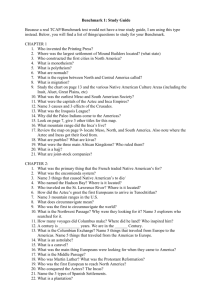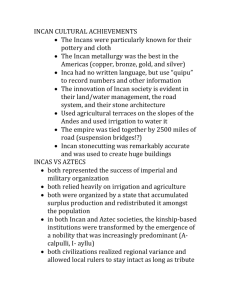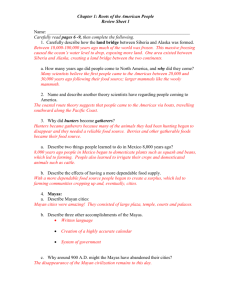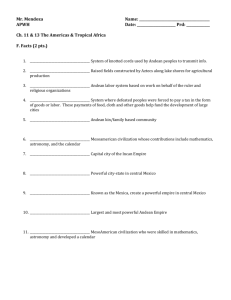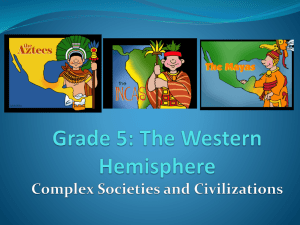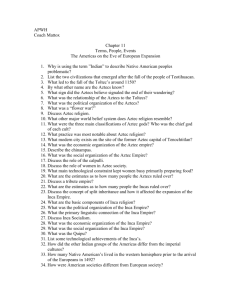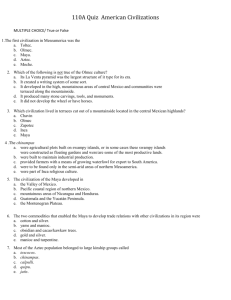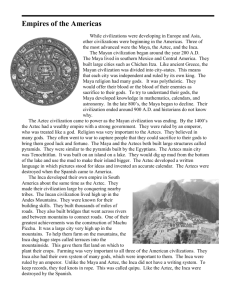World History Unit 4: Chapter 12- The Americas: Pre
advertisement
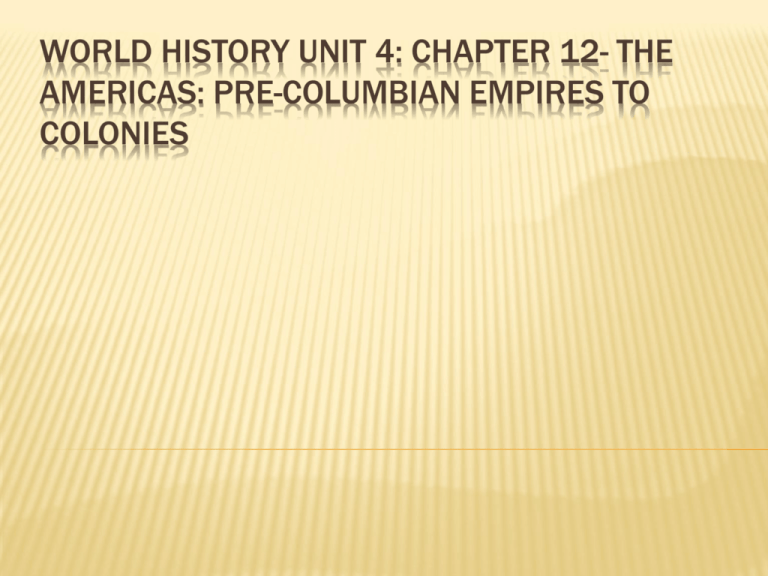
WORLD HISTORY UNIT 4: CHAPTER 12- THE AMERICAS: PRE-COLUMBIAN EMPIRES TO COLONIES INTRODUCTION In this chapter, you will learn about the earliest civilizations in the Americas. Then you will learn about the voyage of Columbus across the Atlantic in 1492 to reach Asia, and how this voyage led to the first encounter between Europeans and Native Americans. Finally, you will learn about the effects of this on the Americas, Europe, Africa, and Asia. ESSENTIAL QUESTIONS What were the major characteristics of the Maya, Inca, and Aztec civilizations? How did the voyages of Christopher Columbus forever change the world? VOCABULARY Pre-Columbian Empires Maya Inca Aztec Prince Henry Christopher Columbus Columbian Exchange Vasco da Gama Ferdinand Magellan Hernando Cortes Conquistadores Montezuma Francisco Pizarro Encomienda System New France New Netherland Atlantic Slave Trade “Middle Passage” IMPORTANT IDEAS A. The Maya, Inca, and Aztec peoples developed complex civilizations in Mexico, Central America, and Peru before the arrival of Christopher Columbus. They grew corn and many other food crops unknown in Europe. They developed their own calendars, mathematics, and engineering skills. B. The Renaissance spirit of inquiry and new technologies like the compass, encouraged Europeans to engage in overseas exploration in the 1400s. C. Columbus' "first voyage" led to the first encounter between Europeans and the Americans in 1492. This encounter led to the introduction of new foods, livestock, and diseases in both hemispheres, known as the Columbian Exchange. D. The Spanish conquest of the Aztecs and Incas led to European colonization of the Americas, the introduction of Christianity, and the deaths of millions of Native Americans to European diseases. E. Europe was enriched from plundering and colonizing the Americas and from increased trade. F. European colonization of the Americas had a great impact on Africa. Africans were enslaved and shipped to the Americas in the Atlantic slave trade. THE EMPIRE OF THE AMERICAS While complex civilizations were emerging in Asia, Africa, and Europe, equally striking developments had occurred in the Americas. In this chapter you will review the chain of events set into motion when these two halves of the world collided in 1492. The "encounter" of Europeans with the peoples of the Americas brought the major civilizations of the world together for the first time. This encounter had a profound impact on all peoples. THE FIRST AMERICAS Scientists believe that during the last Ice Age, Asia and Alaska were attached by a landbridge where the Bering Straits are found today. As long as 25,000 years ago, groups of Asian hunters crossed this landbridge in search of food, following the migrations of animal herds. From Alaska, these earliest Americans spread southwards. Over time, these people multiplied and spread throughout North America, Central America, the islands of the Caribbean, and South America. Separated by vast mountains and dense jungles, these people developed their own separate languages and cultures. They settled along lakes and rivers, where they had fresh water to drink. "Native Americans" experienced their own Neolithic Revolution in which they learned to grow corn (maize) and other crops. Several complex civilizations emerged in Mesoamerica (presentday Mexico and Central America). Historians refer to these civilizations as preColumbian because they existed in the Americas before the arrival of the explorer Columbus in 1492. Unlike the early civilizations of Africa and Eurasia, the first Native American civilizations did not emerge in river valleys. Native Americans living in the warm and humid rain forests of Mesoamerica learned to plant corn, a crop unknown to the peoples of Africa, Asia, and Europe. Corn became the basic food crop in the Americas, supporting the development of permanent settlements and large cities. THE MAYA (1500 B.C.-1546 A.D.) Among the earliest civilizations in the region were the Olmecs and the Toltecs. Over 3,000 years ago, the Maya developed a complex civilization in present-day Guatemala. Each Maya city had its own chief ruler, who was considered half-man and half-god. Most Maya were peasant farmers, who lived in thatched huts and grew corn. There was also a small class of craftsmen, who made luxuries for the Maya nobles. The nobility were a small hereditary class, who performed sacred ceremonies on special occasions and assisted the rulers. Maya astronomers measured the movement of the sun, moon, and Venus to predict the future. Mayan observatory The Maya engaged in frequent wars and practiced human sacrifices. They developed a ball game that became popular throughout the Americas. Two teams competed on a rectangular court, each attempting to hit a solid rubber ball into wooden rings. Archaeologists believe the game had a religious significance. The losing team was sometimes sacrificed to the gods after the game. Around the 9th century, Maya culture experienced a great crisis. Archaeologists do not know if a food shortage, epidemic, or great war brought an end to this classic period of Maya civilization. The Maya migrated northward to the Yucatan Peninsula in present-day Mexico. There, they built a new series of city-states. One of these later Mayan cities is well-preserved at Chichen Itza. Constant warfare from the 13th to the 16th centuries, and pressures from neighboring wandering peoples, led to the final decline of Maya civilization. THE AZTECS (1200-1521) The Valley of Mexico, in the center of Mexico, has a high elevation and a temperate climate. Its location is excellent for growing crops. The Aztecs (or Mexica) were an alliance of several local peoples. Around 1300, they settled on an island in the center of the Valley of Mexico. They learned to grow corn from their neighbors. In order to survive, they grew crops in “floating gardens" in wet, marshy lands. They made careful observations of the sky and aligned their temples based on the movements of the sun and moon. Over the next two centuries, the Aztecs engaged in frequent wars to conquer other peoples in the region. These conflicts continued until the arrival of the first Europeans in the Americas. The Aztecs developed a highly complex social organization. At the top of Aztec society was an all-powerful emperor. Below the ruler were the nobles, who often held high positions in the government, army, or priesthood. Most people were commoners, working as farmers, fishermen, craftsmen, or as warriors in the Aztec armies. At the bottom of Aztec society were slaves. Like other Native American cultures, the Aztecs worshipped many gods. The most important was the Sun God. Their observations of the sky made it possible to construct accurate calendars of stone. The Aztecs believed the Sun God needed human blood to continue his daily journeys across the sky. For this reason, the Aztecs practiced human sacrifices on a massive scale. Captured warriors from other tribes were sacrificed, as well as Aztecs who volunteered for this honor. They believed their sacrifice was necessary to keep the universe in motion. The Aztec Sun Stone, also known as the Aztec Calendar Stone, at National Museum of Anthropology, Mexico City THE INCA EMPIRE (12001535) Thousands of miles to the south of Mexico, advanced cultures developed along the Pacific coast and in the Andes Mountains of South America. Peoples in the Andes terraced mountains and grew potatoes and other root crops that could resist the cold nights. They kept llamas and alpacas for their meat and wool and to carry goods. The Inca built upon the achievements of these earlier peoples. Around 1400, the Inca began extending their rule across the Andes. Eventually, the Inca ruled an empire covering much of present-day Peru, Ecuador, Bolivia, and Chile. The Inca built stone roads stretching over ten thousand miles to unite the distant comers of their empire. Food was preserved and kept in storehouses along the roads. The Inca never developed carts with wheels, possibly because such vehicles were unsuited to the rugged terrain of the Andes Mountains. The Inca also never developed a form of writing. Instead, they used quipu - bundles of knotted and colored ropes to count, keep records, and send messages. Their superb engineering skills allowed them to construct vast stone buildings high in the Andes. They had no cement, but fitted stones of their buildings perfectly together. The ruins of Machu Picchu, an ancient fortress city in the Andes Mountains, provide the best surviving example of Inca building skills. Many of the building blocks weigh 50 tons but are so precisely fitted together that the joints do not permit a thin knife blade to be inserted. ART Pre-Columbian art was highly developed. Maya, Aztec and Inca artists made stone sculptures to decorate the sides of temples and palaces. They made ceramic bowls carved with human and animal forms across the front for religious ceremonies. Often these were used to ward off demonic spirits believed to be lurking in the afterlife. Mayan relief sculpture from Palenque, Mexico An Incan polychrome jar from 14711493. GENDER ROLES IN MESOAMERICA Gender roles were established at birth. Boys were given a machete (a type of knife with a wide blade) by their fathers to help establish their masculine role. Girls received a stone instrument from their mothers, used to grind maize. Boys were taught crafts, and girls were taught to cook and other necessities. Women held various roles in the family, from harvesting grains and preparing food, to caring for animals. Aside from childbearing and raising children, one of women's major jobs was making maize into flour. After being boiled, the maize kernels were ground by stone into dough. Women could hold jobs outside the home. Some sold goods in the market or were skilled artisans. Others were priestesses who worked in temples. THE COLUMBIAN EXCHANGE The writings of Marco Polo had increased European interest in trade with Asia. Goods, especially spices and silks, were carried overland to Constantinople and then shipped across the Mediterranean by the Italian city-states. The conquest of the Byzantine Empire by the Ottoman Turks in 1453 temporarily cut off Europe from overland trade with East Asia. As a result, incentives were created to find a new route to the East, especially by an allwater passage. At the same time, the spirit of inquiry of the Renaissance was leading Europeans to explore the oceans. Europeans adapted technological innovations from other cultures to improve their navigation skills, including the compass from China and the triangular lateen sail used by Arab ships. THE AGE OF DISCOVERY Spain and Portugal Lead the Way. Spain and Portugal are located at the western end of Europe. Spain has coasts on the Mediterranean Sea and the Atlantic Ocean. Both countries were determined to gain a share of the trade with Asia, and had the resources needed to finance costly overseas exploration. Prince Henry of Portugal developed a new, lighter sailing ship and sponsored expeditions along the coast of Africa. Spain's rulers, Ferdinand and Isabella, had just completed the Reconquista (reconquest) of Spain's Muslim areas - reuniting the country under Christian rule in 1492. In the same year, they expelled Spain's Jewish community. Spain's rulers hoped to further spread the Christian faith and to glorify their country through overseas exploration. Ferdinand on the left with Isabella on the right. The inscription above identifies them as "Lord Ferdinand and Lady Isabella, Kings of Castille and of Aragon". THE VOYAGES OF CHRISTOPHER COLUMBUS Christopher Columbus (1451-1506), a sea captain from Genoa in Italy, was convinced that he could reach Asia by sailing westward. After years of seeking support, he finally persuaded the rulers of Spain to provide him with three ships in 1492. Columbus actually thought the world was smaller than it was. After two months at sea, his men almost mutinied. Then they accidentally landed in the Americas instead of reaching the East Indies. His "discovery" of the Americas provided new sources of wealth and raw materials that would forever alter the economy of Europe. Columbus' encounter with the peoples of the Americas quickly led to an important exchange of products and ideas, known as the Columbian Exchange. The European diet was greatly improved by the introduction of new American foods such as tomatoes, corn, potatoes, peppers, squash, pineapples, and chocolate. Also, such animals as turkeys provided a new food source for Europeans. Tobacco was also brought to Europe. At the same time, wheat, sugar, cattle, horses, pigs, sheep, chickens and grains such as wheat were introduced from Europe into the Americas. THE COLUMBIAN EXCHANGE LATER EXPLORERS After Columbus’ great success, Europeans competed with one another in sending out explorers to find new trade routes and to seek new lands. VASCO DE GAMA (1460-1524) A Portuguese explorer, Vasco Da Gama discovered an all-water route from Europe to India by sailing around the southern tip of Africa in 1497. His discovery made it possible for Europeans to obtain Asian goods without relying on overland routes. FERDINAND MAGELLAN (1480-1521) In 1519, Magellan, another Portuguese explorer, led the first expedition of ships to circumnavigate (circle) the world. Sailing around South America and across the Pacific, Magellan proved conclusively that the world was round. Magellan himself died on the voyage. OTHER EXPLORERS England, France, and Holland each sent their own explorers to find an all-water route to Asia and to claim new lands. Based on the voyages of John Cabot, England claimed territories in North America. France sent Jacques Cartier, Samuel Chaplain, and Robert de la Salle to explore the St. Lawrence River, the Great Lakes, and the Mississippi River. The Dutch sent Henry Hudson on a quest to find a shortcut from Europe to the Far East. Hudson explored Hudson Bay in Canada and the Hudson River in America in hopes of finding a “Northwest Passage” to Asia. John Cabot’s explorations leading England to claim territories in North America. THE CONQUEST OF THE AMERICAS The impact of the arrival of the Europeans was especially profound on the Native Americans. Spanish conquistadors (conquerors) and priests arrived soon after the first explorers. They came to conquer native peoples, seize gold and silver, obtain natural resources, and convert the natives to Christianity. THE CONQUEST OF MEXICO Soon after Columbus' first voyage, the Spanish conquered the main Caribbean islands. Small numbers of Spanish soldiers, using horses and firearms, and acting with local allies, were quickly able to overcome large numbers of Native Americans. In 1519, Hernan Cortes sailed from Cuba to Mexico with a small force of soldiers in search of gold and silver. Cortes met the Aztec Emperor Montezuma. The Aztecs at first believed the Spaniards were gods and showered them with gifts. Later, Cortes left Tenochtitlan, the Aztec capital, and made allies with the enemies of the Aztecs. With a few hundred Spaniards and several thousand Native American warriors, Cortes attacked Tenochtitlan in 1521. Several factors explain Cortes' final triumph. The Aztecs fought with clubs, spears and bows, while the Spaniards had guns, steel swords, shields, dogs, horses and cannons. The Spaniards also gathered a large force of native warriors from neighboring peoples who opposed the Aztecs. Finally, the Aztecs were worn down by an outbreak of smallpox, accidentally introduced by the Europeans. The Aztecs had no immunity to this disease. As a result, Cortes was quickly able to conquer the Aztec Empire . THE CONQUEST OF PERU In 1530, Francisco Pizarro set sail from Panama to conquer the Inca of Peru. Pizarro arrived just when the Inca were recovering from a brutal civil war. High in the Andes Mountains, Pizarro and a handful of soldiers faced a much larger force of Inca warriors. Again, the Native Americans could not resist the more technologically advanced Europeans. Pretending friendship, Pizarro invited the Inca emperor to visit him. Pizarro and his army next ambushed the Incas and murdered the emperor. Pizarro was then able to conquer the Inca capital by 1533. The Spanish treated the conquered Indians harshly. The defeated Indians were forced to accept the Christian religion and to labor for their new rulers. Pizarro meets with the Inca emperor Atahualpa, 1532 COLONIAL LATIN AMERICA The Spanish conquest of the Caribbean, Mexico, and Peru brought many important changes. Although their explorations did not find the cities of gold they were seeking, the Spanish asserted their dominance, religion and culture on the native tribes. The region was transformed into Latin America - a fusion of European and Native American cultures. COLONIAL GOVERNMENT As a result of these conquests, Spain now ruled an American empire many times larger than Spain itself. Special royal governors, known as viceroys, were sent to rule the colonies in the king's name. Officials born in Spain filled the most important positions in the colonial government and the military. Gold and silver from the Americas were shipped to Spain, making it the strongest power in Europe in the 16th century. COLONIAL SOCIETY The conquered lands were often divided among the soldiers. They used Native Americans to till the land and work the mines. This system of forced labor was called the encomienda system. Church leaders also formed an elite class and shared in political power. Priests sought to convert Native Americans to Catholicism, while preventing their actual enslavement. The Jesuits, the religious order founded in the CounterReformation, built schools, founded hospitals, and taught agricultural skills. However, in 1767, the Jesuits were expelled from Latin America. Gradually, a new colonial order emerged. At the top of society were noble officials and landowners who were born in Spain (peninsulares). They formed the head and heart of colonial society in Latin America. Just below them were those with a Spanish background born in the New World (creoles). Below this group were those of mixed Spanish and Native American ancestry (mestizos). At the bottom of the social scale were Native Americans, who performed most of the hard work. Meanwhile, Native American populations declined because they had no immunity to diseases from the Eastern Hemisphere like measles and smallpox. Until the coming of the Europeans, the New World had been free of smallpox, typhus, and measles. Because of the sharp decline in the Native American population from these new diseases and overwork, Spanish landowners in the Caribbean and Brazil needed a source of labor able to survive the harsh working conditions. As a result, they turned to importing Africans as slaves. OTHER EUROPEAN COLONIAL EMPIRES New France. New France was established in Canada and along the Great Lakes and Mississippi River. New France never became as populous as the Spanish or English colonies. It consisted of a handful of towns and a series of trading outposts. French missionaries arrived in the Americas to convert the Native American Indians to Christianity. By the end of the seventeenth century, French territory covered almost three-fourths of North America. The region continued to attract French explorers who found that the region contained valuable fur-bearing animals, especially beavers - whose pelts were greatly desired by Europeans for making hats. New Netherland. Based on Henry Hudson's explorations, the Dutch claimed control of the region around present-day New York. They set up a successful fur trade with the native peoples of the Hudson River Valley and called their colony New Netherland. The Dutch government gave control of the colony to the merchants of the Dutch West India Company. In 1624, thirty families came to settle in Fort Orange (present-day Albany). More settlers arrived the next year and established a second fort at the tip of Manhattan island. They named this settlement New Amsterdam after the Dutch city of Amsterdam. The city of New Amsterdam, with its fine natural harbor, became a leading center for trade. The English Colonies. The first permanent English colony in the "New World" was established by a private company at Jamestown, Virginia in 1607. The first settlers were men who came in search of gold. Despite initial challenges, the colony at Jamestown became profitable by growing tobacco for sale in Europe. A second English colony was founded by a Protestant group known as the Pilgrims. They landed at Plymouth Rock. Another group of English Protestants, the Puritans, landed in nearby Massachusetts Bay in 1630. They came to practice their own religious beliefs without persecution. Eventually, the number of English colonies along the Atlantic coast of North America expanded to thirteen - from Georgia to Massachusetts. THE ATLANTIC SLAVE TRADE Finding enough workers able to survive harsh working conditions became a major problem for many of the colonies, especially in the Caribbean. The solution to the problem led to one of the most negative aspects of the European conquest of the Americas - the rise of the slave trade. Slavery had existed in Africa long before European intervention. However, the new Atlantic slave trade expanded the institution of slavery on a scale unparalleled in human history. Enslaved people were usually captured by powerful African tribes in raids on neighboring villages. The slaves were brought to the West Coast of Africa where they were imprisoned in fortified castles and traded to European and American slave traders in exchange for guns and other goods. It is estimated that the Atlantic slave trade took away as many as 15 million African men and women over the next three hundred years. More than 11 million of these went to the Spanish colonies. Many died during the “Middle Passage,” the voyage across the Atlantic, because of the horrible conditions they endured on board the ships. Once they arrived in the Americas, most Africans worked long hours in the sugar fields of the Caribbean and Brazil, or toiled raising tobacco and cotton in North America.

